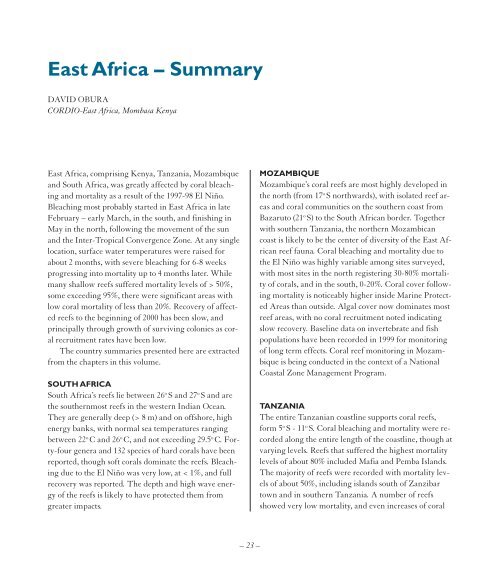Create successful ePaper yourself
Turn your PDF publications into a flip-book with our unique Google optimized e-Paper software.
East Africa – Summary<br />
DAVID OBURA<br />
<strong>CORDIO</strong>-East Africa, Mombasa Kenya<br />
East Africa, comprising Kenya, Tanzania, Mozambique<br />
and South Africa, was greatly affected by coral bleaching<br />
and mortality as a result of the 1997-98 El Niño.<br />
Bleaching most probably started in East Africa in late<br />
February – early March, in the south, and finishing in<br />
May in the north, following the movement of the sun<br />
and the Inter-Tropical Convergence Zone. At any single<br />
location, surface water temperatures were raised for<br />
about 2 months, with severe bleaching for 6-8 weeks<br />
progressing into mortality up to 4 months later. While<br />
many shallow reefs suffered mortality levels of > 50%,<br />
some exceeding 95%, there were significant areas with<br />
low coral mortality of less than 20%. Recovery of affected<br />
reefs to the beginning of <strong>2000</strong> has been slow, and<br />
principally through growth of surviving colonies as coral<br />
recruitment rates have been low.<br />
The country summaries presented here are extracted<br />
from the chapters in this volume.<br />
SOUTH AFRICA<br />
South Africa’s reefs lie between 26 o S and 27 o S and are<br />
the southernmost reefs in the western Indian Ocean.<br />
They are generally deep (> 8 m) and on offshore, high<br />
energy banks, with normal sea temperatures ranging<br />
between 22 o C and 26 o C, and not exceeding 29.5 o C. Forty-four<br />
genera and 132 species of hard corals have been<br />
reported, though soft corals dominate the reefs. Bleaching<br />
due to the El Niño was very low, at < 1%, and full<br />
recovery was reported. The depth and high wave energy<br />
of the reefs is likely to have protected them from<br />
greater impacts.<br />
MOZAMBIQUE<br />
Mozambique’s coral reefs are most highly developed in<br />
the north (from 17 o S northwards), with isolated reef areas<br />
and coral communities on the southern coast from<br />
Bazaruto (21 o S) to the South African border. Together<br />
with southern Tanzania, the northern Mozambican<br />
coast is likely to be the center of diversity of the East African<br />
reef fauna. Coral bleaching and mortality due to<br />
the El Niño was highly variable among sites surveyed,<br />
with most sites in the north registering 30-80% mortality<br />
of corals, and in the south, 0-20%. Coral cover following<br />
mortality is noticeably higher inside Marine Protected<br />
Areas than outside. Algal cover now dominates most<br />
reef areas, with no coral recruitment noted indicating<br />
slow recovery. Baseline data on invertebrate and fish<br />
populations have been recorded in 1999 for monitoring<br />
of long term effects. Coral reef monitoring in Mozambique<br />
is being conducted in the context of a National<br />
Coastal Zone Management Program.<br />
TANZANIA<br />
The entire Tanzanian coastline supports coral reefs,<br />
form 5 o S - 11 o S. Coral bleaching and mortality were recorded<br />
along the entire length of the coastline, though at<br />
varying levels. Reefs that suffered the highest mortality<br />
levels of about 80% included Mafia and Pemba Islands.<br />
The majority of reefs were recorded with mortality levels<br />
of about 50%, including islands south of Zanzibar<br />
town and in southern Tanzania. A number of reefs<br />
showed very low mortality, and even increases of coral<br />
– 23 –


















